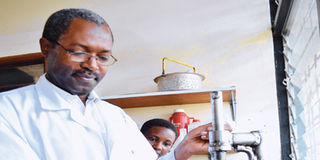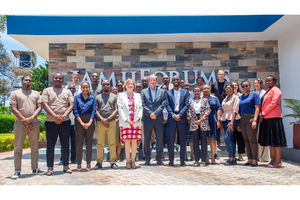Clear banana juice? Yes please!

Dr Kibazohi prepares clear banana juice in the lab at University of Dar es Salaam’s College of Engineering (CoET).
PHOTO | SALHIM SHAO.
What you need to know:
It is such burning desire that compelled Dr Kibazohi in 1993, then a fresh graduate beaming with a degree in mechanical engineering from the University of Waterloo, to try preparing the juice from the comfort of his house using a blender.
Picture somebody gulping down a glass of banana juice.
Wondering how on earth could juice be made from a banana fruit?
The unique innovation of doing so is now available in the country; in fact, it is only available in Tanzania, thanks to Dr Oscar Kibazohi, 53, a senior lecturer at the College of Engineering and Technology (CoET) at the University of Dar es Salaam.
Such an innovation has seen his name etched among 11 other technology entrepreneurs, affiliated with African universities and research institutions, selected as part of the first year of the Royal Academy of Engineering Prize.
The Prize is already Africa’s biggest prize devoted to engineering innovation, covering all disciplines from mechanical, civil and computing to biomedical, oil and gas, mining and electronic engineering.
Growing up in a village in Kagera, a young Kibazohi used to be amazed at the way men and women in his village manufactured traditional brew from ripe bananas. What caught his eye was how these men and women struggled to make juice out of the fruits.
“They had to step on the fruits as a way of mashing them and the end product was not real juice as it was not that clear, they failed to achieve the desired goal,” says the academician.
In his heart, Dr Kibazohi was burning with the desire of one day being the first person in the world to come up with the innovation of preparing clear banana juice.
Giving the blender a try
“The big question lingering in my mind was when and how I would achieve this,” he says.
He says the making of fluids from ripe bananas which he refers to as indigenous innovation was practiced in Kagera, Kigoma, Rwanda, Burundi, Uganda and East Zaire.
“I was not happy with how the drink was prepared in those days; I said to myself that I had to do something about it”.
It is such burning desire that compelled Dr Kibazohi in 1993, then a fresh graduate beaming with a degree in mechanical engineering from the University of Waterloo, to try preparing the juice from the comfort of his house using a blender.
After several unsuccessful attempts, Dr Kibazohi had to bury himself in books once again. He went to Canada for his PhD studies in 1995. It is there were he made his intent known before his supervisor about the local technology and his desire of improving it.
“The professor ignored the idea and I still do not blame him because to him, that was out of context and he as a matter of fact, felt that there were other important things that I ought to have been doing,” he says with a chuckle.
In the early 2000s when he returned to Tanzania, the determined academician made the most of the advent of the Internet with the aim of developing and improving the local innovation. A random search on the web on Banana juice landed him on an abstract published by one Kyamuhangire, an academician from Makerere University in Uganda.
He thus made a point of meeting Kyamuhangire and that did not take him long. It was at a Lake Victoria Research Initiative where he was among the academicians invited to write some proposals on Lake Victoria Basin.
Such proposals and researches saw him travel to Makerere University in pursuit of Kyamuhangire.
From Masaka to the other parts of Western Uganda, Dr Kibazohi toured a better part of Uganda, researching on preparing the juice.
It is here where he established that bananas that had tannins were appropriate for the drink when mashed well, without being stepped on as it was done by the elders in his village. From there on, it had been one experiment after the other; all he wanted to see was clear banana juice, well prepared for human consumption.
Clear juice in less time
Dr Kibazohi took the innovation to his colleagues at CoET and after they were impressed, he also shared it with some of his students.
A peek of Dr Kibazohi’s office at the University of Dar es Salaam will land you to a number of peeled bananas and others in waiting, as he prepares the juice without the addition of enzymes or extraction aids.
On the corridors of CoET Dr Kibazohi would always be pondering on the next improvement of the juice. “Now I can prepare clear banana juice in only 20 minutes, unlike in the past where they would spend more time stepping on the bananas,” he says.
According to him, clear banana juice is difficult to produce because pulping ripe bananas produces a highly viscous puree. His innovation uses mechanical mashing of bananas without the addition of enzymes or extraction aids to create clear banana juice.
It mirrors the traditional process of kneading a mixture of ripe banana and grass or fibres until the juice oozes out from the pulp. The technology allows for juice-producing banana varieties, which fetch low prices and are being phased out, to be transformed into a more valuable product.
And when an invitation from the Royal Academy of Engineering in the United Kingdom came knocking, he did not give it a second thought than sending his innovation as an entry.
“I did not hesitate in submitting my entry, it is really an honour and indeed makes me proud to be the only innovator from Tanzania to make it in the awards,” he says.
Though his innovation exposes him to making some money, Dr Kibazohi has not set his sight on any cash.
“This is a unique innovation, it is an opportunity of making money but I view it as a way of giving back to the community, I believe that is what innovators are supposed to do”.
Should the innovation be scaled up further, Dr Kibazohi sees big companies going for it as they scramble for market, a move he thinks he would benefit from.
“I pioneered the innovation, I’m pretty much sure that I’ll have a share of the spoils,” he says.
At the moment, being an employee of the University of Dar es Salaam, it is the higher learning Institution that has Intellectual property rights of the innovation.
The winner of the award will be announced mid next year.
Email:[email protected]




